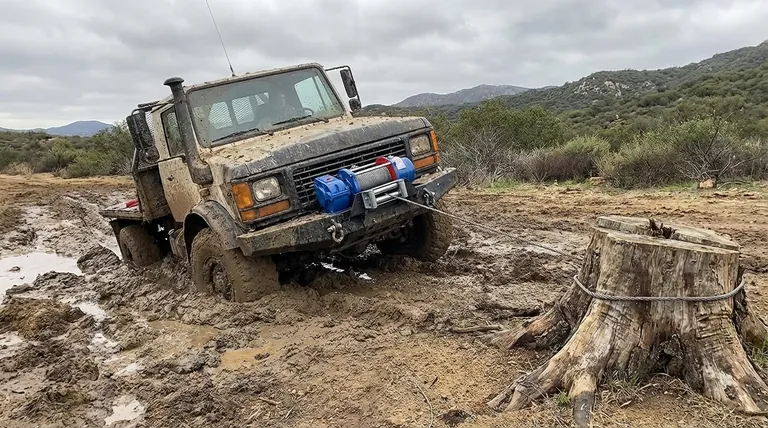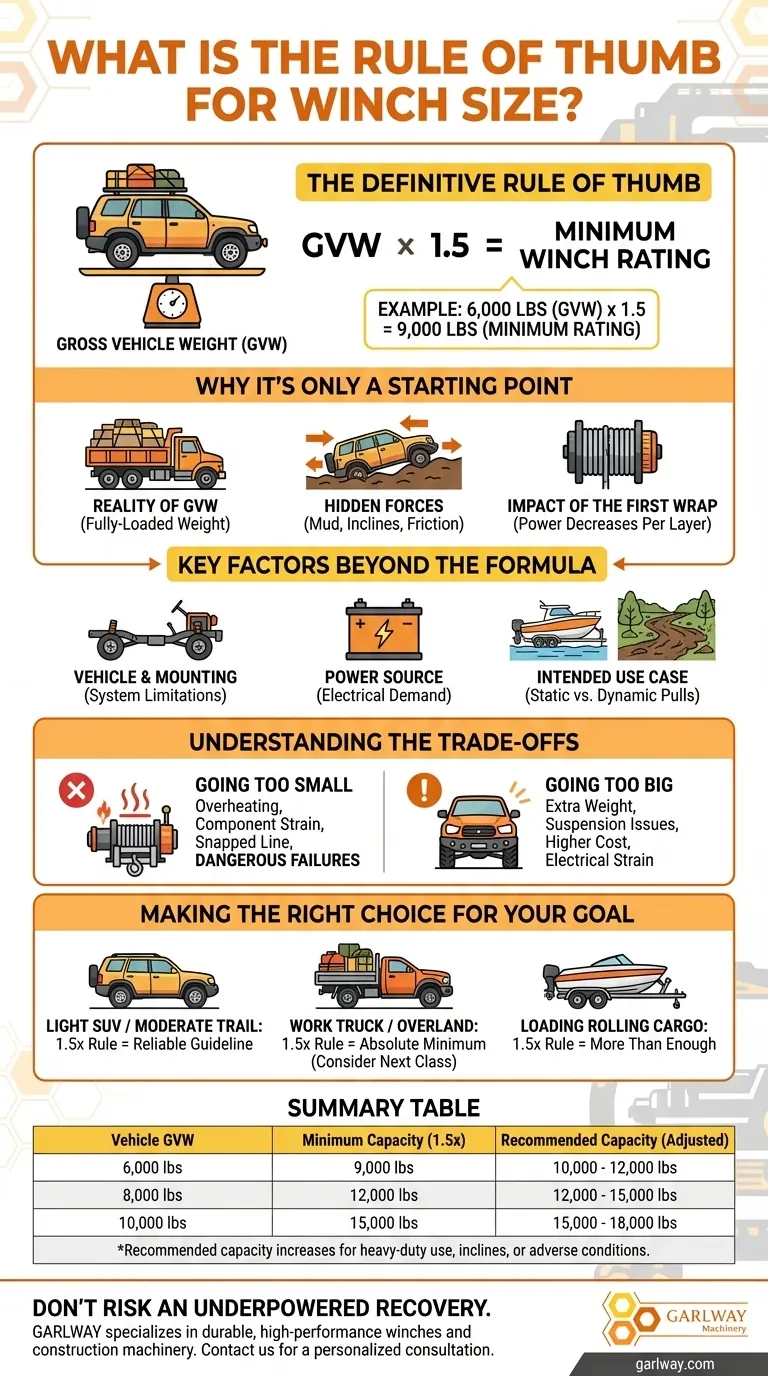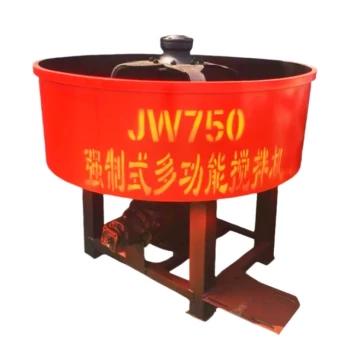The definitive rule of thumb for choosing a winch is to multiply your vehicle's Gross Vehicle Weight (GVW) by 1.5. This calculation gives you the minimum rated pulling capacity you should consider. For example, a vehicle with a GVW of 6,000 lbs requires a winch with a minimum rating of 9,000 lbs (6,000 x 1.5 = 9,000).
While the 1.5x formula is the accepted industry starting point, it assumes ideal conditions. Real-world recoveries involve overcoming resistance from mud, water, and inclines, meaning this formula represents the absolute minimum for safe operation, not necessarily the optimal choice.

Why the "Rule of Thumb" Is Only a Starting Point
The 1.5 multiplier isn't arbitrary; it's a safety factor designed to account for variables beyond the simple dead weight of a vehicle. Understanding these variables is critical to making an informed decision.
The Reality of Gross Vehicle Weight (GVW)
Your vehicle's GVW is its maximum operating weight, including the vehicle itself, fuel, cargo, and passengers. Always use this fully-loaded figure, not the empty curb weight, as the basis for your calculation.
The Hidden Forces: Resistance and Friction
A vehicle's weight is only one part of the equation. The force required to move it increases dramatically when it's stuck.
The winch must overcome additional resistance from factors like deep mud, sticky clay, snow, or the suction from water. Pulling a vehicle up a steep incline also adds significant load.
The Impact of the First Wrap
A winch's advertised pulling capacity applies only to the first layer of cable wrapped around the drum.
With each additional layer of cable on the drum, the winch's effective pulling power decreases. A winch may lose 10-15% of its power per layer, meaning a 10,000 lb winch might only pull 7,500 lbs on its final wrap.
Key Factors Beyond the Basic Formula
To truly select the right winch, you must move beyond the simple formula and consider the context of its use and the platform it's mounted on.
The Vehicle and Its Mounting Platform
The winch is part of a system. Its effectiveness is limited by the vehicle's own capabilities.
Ensure your vehicle's frame and the winch bumper or mounting plate are strong enough to handle the forces generated. A 12,000 lb winch on a mount rated for 8,000 lbs is a recipe for catastrophic failure.
The Vehicle's Power Source
Winches, particularly electric ones, place a heavy demand on your vehicle's electrical system.
A large winch can draw hundreds of amps under load, potentially overwhelming a stock alternator and battery. Upgraded electrical systems are often necessary for reliable operation of higher-capacity winches.
The Intended Use Case
The demands of loading a boat onto a trailer are vastly different from a self-recovery situation on a remote trail.
Dynamic recoveries from mud or steep angles require more capacity and durability than the more predictable, static pulls of loading rolling cargo.
Understanding the Trade-offs
Choosing a winch isn't just about finding the biggest number. There are practical consequences to your choice.
The Danger of Going Too Small
This is the most critical mistake to avoid. An underpowered winch will overheat, strain its components, and risk snapping the winch line.
An overloaded winch not only fails the recovery but creates an extremely dangerous situation for everyone involved. Safety is the primary reason to never go below the 1.5x rule.
The Downsides of Going Too Big
While it may seem safer, a vastly oversized winch has drawbacks. It adds significant weight to the front of your vehicle, which can negatively affect suspension performance and handling.
Larger winches are also more expensive and place a greater strain on your vehicle's electrical system, potentially requiring costly upgrades. The goal is to find the right tool for the job, not the heaviest one.
Making the Right Choice for Your Goal
Use the 1.5x rule as your baseline, then adjust based on your specific situation and risk tolerance.
- If your primary focus is a light SUV or UTV for moderate trail use: The 1.5x rule is a reliable guideline, providing a safe margin for most common situations.
- If your primary focus is a fully-loaded work truck or overland vehicle: Treat the 1.5x multiplier as the absolute minimum and strongly consider stepping up to the next weight class for a greater safety margin.
- If your primary focus is loading rolling cargo (like a boat or car) onto a trailer: The 1.5x rule offers more than enough capacity, as you are not fighting the extreme resistance of a recovery.
Selecting the right winch is about preparing for the situation you hope to avoid, ensuring you have the power and reliability you need when it matters most.
Summary Table:
| Vehicle GVW (lbs) | Minimum Winch Capacity (1.5x Rule) | Recommended Capacity (Adjusted) |
|---|---|---|
| 6,000 lbs | 9,000 lbs | 10,000 - 12,000 lbs |
| 8,000 lbs | 12,000 lbs | 12,000 - 15,000 lbs |
| 10,000 lbs | 15,000 lbs | 15,000 - 18,000 lbs |
Note: Recommended capacity increases for heavy-duty use, inclines, or adverse conditions.
Don't risk an underpowered recovery. GARLWAY specializes in durable, high-performance winches and construction machinery for professionals worldwide. Our experts will help you select the perfect winch for your vehicle's GVW and intended use, ensuring safety and reliability when it matters most.
Contact GARLWAY today for a personalized consultation and discover how our winches, concrete mixers, and batching plants can power your projects.
Visual Guide

Related Products
- Electric and Hydraulic Winch for Heavy Duty Applications
- Warn Winch Windlass Boat Trailer Winch
- Electric 120V Boat Winch by Badlands
- Best 18000 Pound Drum Anchor Trailer Winch
- 12000 lb Heavy Duty Electric Boat Winch
People Also Ask
- Can an electric winch be used as a hoist? Understand the Critical Safety Differences
- Do electric winches have brakes? Essential Safety for Your Heavy-Duty Pulling
- How to power an electric winch on a trailer? Choose the Best Method for Your Setup
- Can you use an electric winch manually? A Guide to Dual-Functionality Winches
- How is an electric winch powered? Unlock the Power Conversion System for Heavy Lifting



















